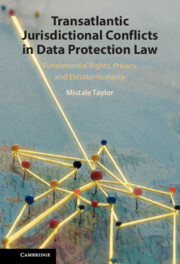 Transatlantic Jurisdictional Conflicts in Data Protection Law
Transatlantic Jurisdictional Conflicts in Data Protection Law Published online by Cambridge University Press: 06 April 2023
The extraterritorial dimension of EU data protection law has inspired conflicts in jurisdiction between the EU and other States, particularly the US, which has markedly different conceptions of data privacy. In terms of processing personal data, the EU prioritises the privacy and security of that data, while the US foregrounds national security, freedom of expression, access to documents, a free and open Internet, and international trade. The EU and US attitudes to privacy can broadly be placed on a spectrum of, at one end, the EU’s focus on human dignity and, at the other end, the US’ emphasis on liberty. These distinctions are malleable and based on generalisations; they are far more nuanced than just a dignity vs liberty dichotomy. Data protection is particularly interesting because it is not nearly a universal value. The EU has an omnibus data privacy regulation and the US has fragmented, sectoral approaches. In the US, the relevant laws concern fair information practices or informational privacy, as opposed to data protection. The US legal system assigns these less normative heft, which is a beginning point for many of the jurisdictional tensions surrounding the reach of EU law.
To save this book to your Kindle, first ensure no-reply@cambridge.org is added to your Approved Personal Document E-mail List under your Personal Document Settings on the Manage Your Content and Devices page of your Amazon account. Then enter the ‘name’ part of your Kindle email address below. Find out more about saving to your Kindle.
Note you can select to save to either the @free.kindle.com or @kindle.com variations. ‘@free.kindle.com’ emails are free but can only be saved to your device when it is connected to wi-fi. ‘@kindle.com’ emails can be delivered even when you are not connected to wi-fi, but note that service fees apply.
Find out more about the Kindle Personal Document Service.
To save content items to your account, please confirm that you agree to abide by our usage policies. If this is the first time you use this feature, you will be asked to authorise Cambridge Core to connect with your account. Find out more about saving content to Dropbox.
To save content items to your account, please confirm that you agree to abide by our usage policies. If this is the first time you use this feature, you will be asked to authorise Cambridge Core to connect with your account. Find out more about saving content to Google Drive.